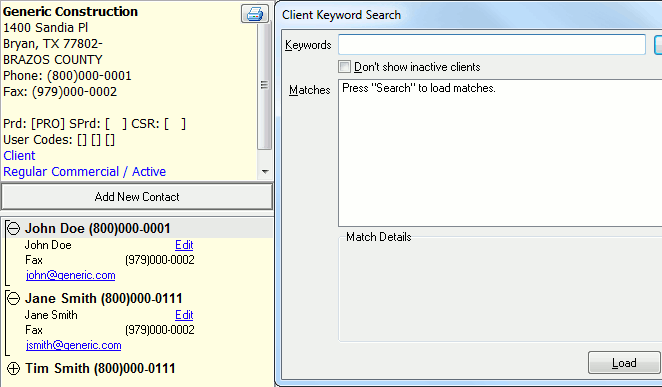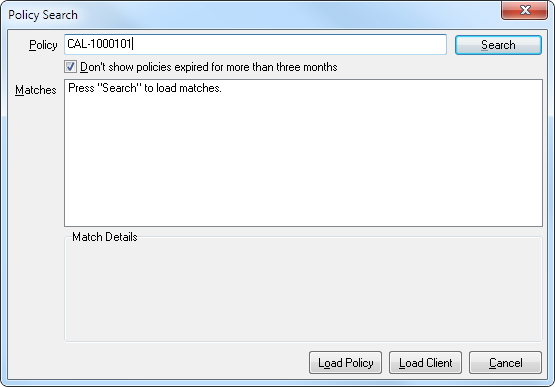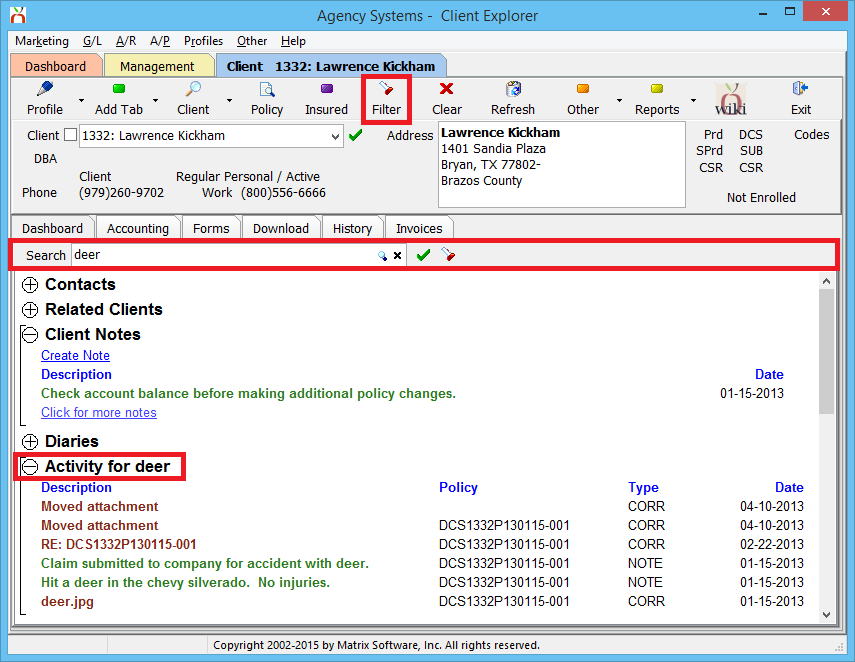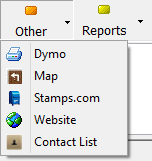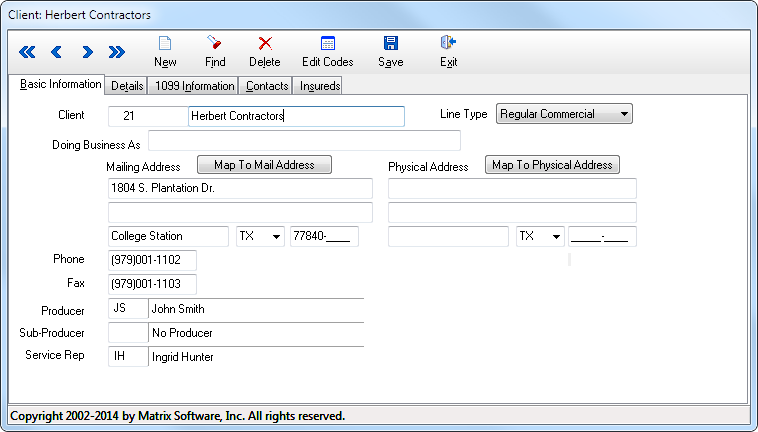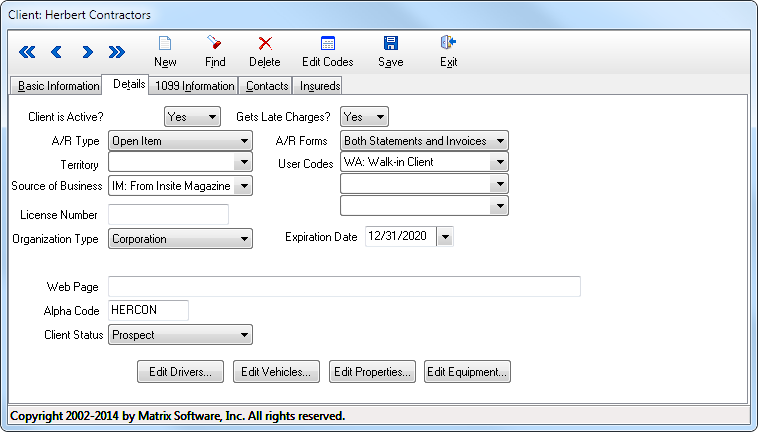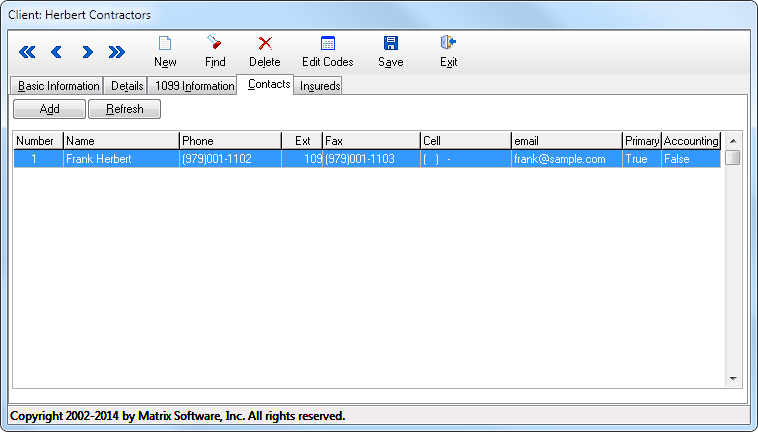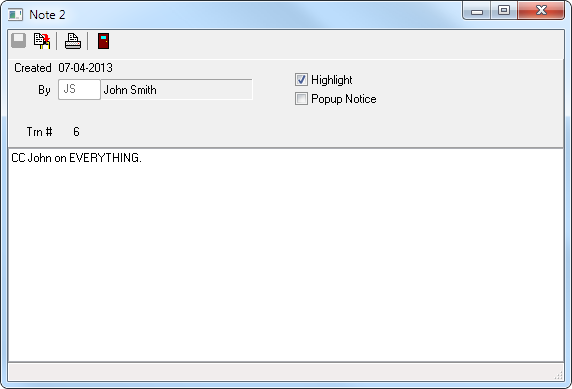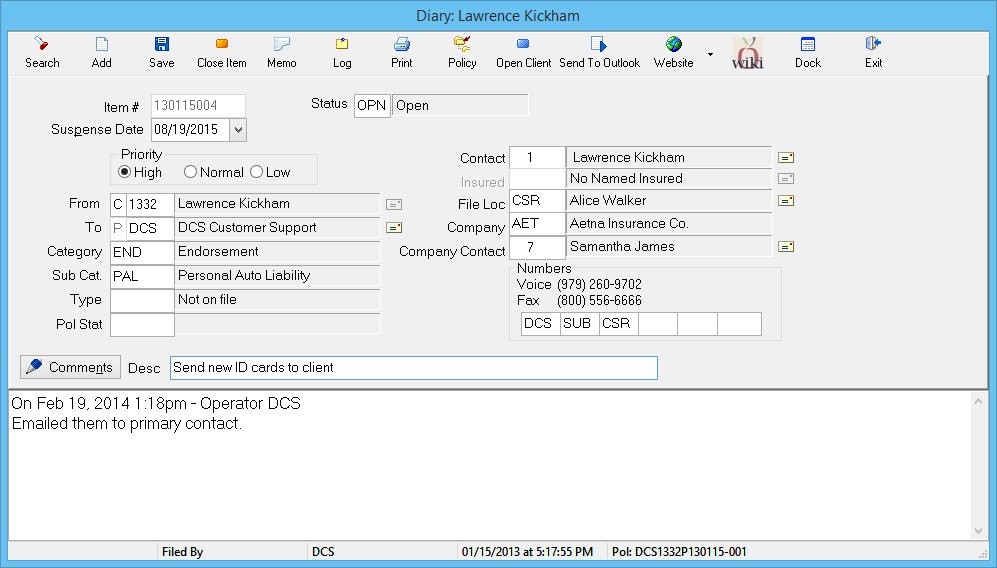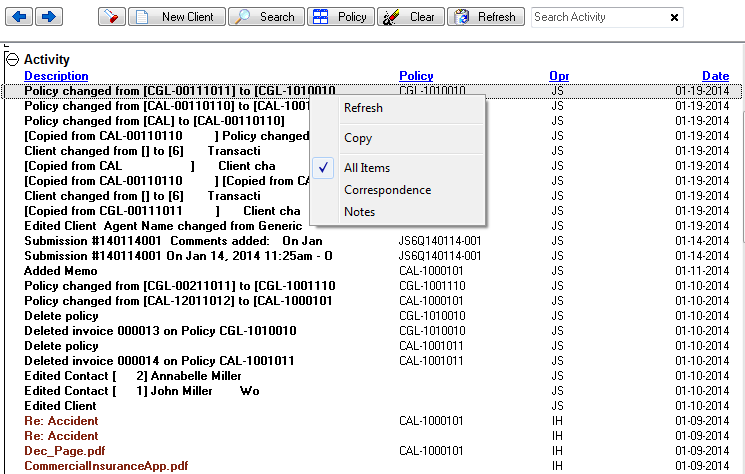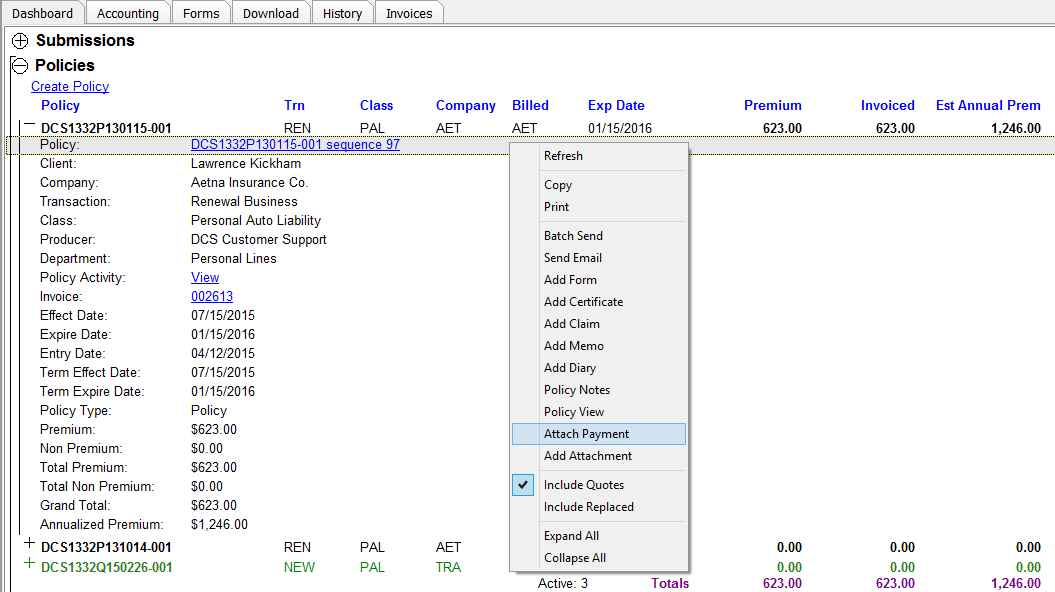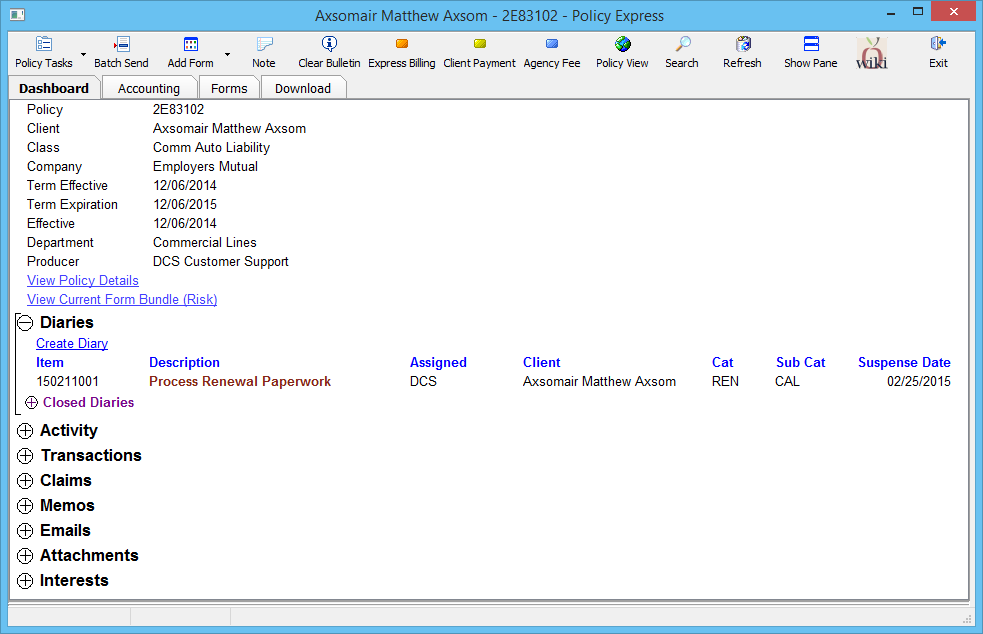Client Tab
| Related Pages |
| Related Categories |
The Dashboard Tab (User), Client Tab, Company Tab, Vendor Tab, Management Tab and Policy Express are the primary dashboards within Agency Systems.
The client tab contains a top toolbar of global client options, client information such as contact numbers and client type, and data tabs for different data types. The client sub-tabs are Client Dashboard, Accounting, Forms, Download, History, and Invoices.
Contents
Find a Client
Multiple client tabs can be opened at the same time, similar to tabs in a browser. When an operator is finished with a client, the current tab can be switched to a new client profile, or the client tab can be closed entirely.
A Client Tab is created by using one of the following methods
- Client Keyword Search.
- Policy Keyword Search.
- Named Insured Keyword Search (GA).
- Add Tab -> Client.
- Dashboard Tab (User): Right-Click -> Open client.
- Client Dashboard -> Related Clients
Client Keyword Search
Click the Search button to search for a client. Client search allows you to find clients by:
- Name
- Address
- Phone number
- E-mail address
A drop-down box displays suggested matches as you type. You can exclude inactive clients. The search includes client contacts as well as drivers.
Client search can find partial matches, including incomplete telephone numbers. The last four digits of a phone number alone are almost always enough to narrow it to a single client.
Client search will locate common aliases, such as Bob or Robert, and abbreviations such as first or 1st.
Policy Keyword Search
You can also search for clients by policy number. Like the client search, the policy-number search displays possible matches while you type and can even locate partial policy numbers and close matches.
Client Tab: Toolbar
The client toolbar is always available for each of the client sub-tabs.
- Profile: Edit the client profile for the current client. Select the drop down to create a new client.
- Add Tab: Create an additional Client, Company, or Vendor tab.
- Client: Perform a Client Keyword Search. The resulting client will replace the current tab with the new client details. Select the drop down to create a new client.
- Policy: Perform a Policy Keyword Search. The resulting client will replace the current tab with the new client details.
- Insured: Perform a Named Insured Keyword Search. The resulting client will replace the current tab with the new client details. The Named Insured filter will be applied to the Diary, Submissions, Policies, and Attachment bands. This button is only visible if the agency type is a GA, or if the option to show the insured search is enabled.
- Filter: Displays the filter toolbar on the Client Dashboard to enter an activity search string. The activity search will filter the Activity, Emails, and Attachments bands on the client dashboard. When the activity filter is applied, the band names will include the search string.
- Clear: Removes any filters, and refreshes the client with the default values.
- Refresh: Refreshes the currently selected client tab, without removing any applied filters.
- Other: Provides access to the DYMO Printer integration, a map to the client address, Stamps.com integration, a link for the client website, or a pop up window for client contacts.
- Reports: Provides a subset of client-specific reports for easy access.
- Wiki: Opens the help documentation on the Newton Wiki for the client tab.
- Pop Out: Opens the client tab as a window and renames the button to "Dock". Select again to reload the client window as a client tab.
- Hide: Collapses the client summary panel from view and renames the button to "Show". Select again to expand the summary panel.
- Exit: Closes the client tab.
Client Tab: Summary Panel
The client summary panel is below the client toolbar. The summary panel includes the client selection drop-down box, and client details.
The client details include the following:
- Client name and number.
- Client DBA name.
- Client phone and fax for commercial lines, or phone1 and phone2 for personal lines.
- Client Type of Regular Personal, Regular Commercial, or Broker Billed and if the client status is a Prospect.
- Client Address.
- Client Producer, Sub Producer and CSR, including both the code and profile name for each.
- Client User Code 1-3 ,Territory, and Source of Business, including both the code and profile name for each.
- Client website address.
- My Insurance Dashboard enrollment status (if enabled).
Client Tab: Summary Panel - Select a Client
The client drop list provides a quick search feature which automatically searches client names for partial or complete matches.
Example: Enter a portion of the client’s name, “kick”. Three results are displayed in the drop-list, which is automatically updated after each additional character. Scroll through the items by using the arrow keys to view the complete name and address information. After the correct client is highlighted, press <enter> to load the full client dashboard.
If the quick search drop list does not find a match, the advanced keyword search options are available from the client toolbar. The Client Keyword Search includes results for additional data fields such as client DBA, contacts, phone numbers, or drivers.
In addition, the client profile can be loaded by entering the client number in the drop-down field, and pressing <Enter> or <TAB> when finished. By default, inactive clients are not included in the drop-down list. To load an inactive client by number, first select the "Include Inactive Clients" check box, or use the Client Keyword Search.
To step through the previous or next client, left-click in the client number field, and use the up and down arrow keys on your keyboard.
Client Tab: View Client as Window
Client, Policy, Diary, Company and Vendor tabs can a be viewed as a window on-the-fly.
Within the top toolbar, select Pop Out to detach the tab, and display the tab as a window.
Select Dock within the toolbar to return the item as a full screen tab.
Client Tab: Create a Client
To enter a new client or prospect into Newton, you should always search existing clients first to avoid creating duplicates. Remember to include inactive clients. Click New Client. Enter the client’s name and address. Enter the zip code and Newton will fill in the city and state.
Select commercial or personal lines. You can also select Broker-Billed type for outside agents who write through your agency. This does not restrict the type of policies and forms the client can have. It is strictly for your information. If you select commercial, “Home” and “Work” numbers change to “Phone” and “Fax.”
Specify the default producer and CSR for this client. It is important to specify the producer because when you add an invoice for this client, this is the default who will receive producer commission unless you change it on the invoice.
Click Save to record your changes.
Details Tab
On the Details tab you can choose:
- Prospect or client
- Active status
- Website
- User defined fields
You can set up User defined fields under the Profiles menu, and use them later for reports.
Contacts Tab
Select the Contacts tab and click Add to add a contact. You can set contact-specific phone and extension, and add an e-mail address. Remember that client search can be used with e-mail addresses, so this is useful for pulling up a contact when you receive an e-mail from them. Enter a contact’s date of birth to use for reports, such as birthday mailings and age-group-targeted marketing. Select Primary to mark this as the primary contact, or Accounting to mark them as the accounting contact. These two will appear first in the list of contacts on the client’s Basic tab.
Client Tab: Dashboard
When you search for and load a client, the client’s dashboard is located below the Summary Panel.
Client Notes
Client notes are used for permanent notes about a client. Highlighted client notes will show up by default. Click for more notes to see notes that aren’t highlighted.
Click Create Note to add a client note. You can choose whether to highlight your note. The text you enter is permanent, and can’t be changed once you save. You _can_ highlight and un-highlight it. Check Popup Notice only for showstopper items. It will pop up a window every time anyone loads the client.
Client notes aren’t indexed for searching, so they’re useful for things you would want to remember about a client but wouldn’t necessarily search for.
Diaries
Diaries, as discussed in the Dashboard overview, are simple follow-up or to-do items. Click a Diary to open it. Click in any of the fields to change or add information or modify the designee. When you update a Diary, don’t forget to update the suspense date to show it is up-to-date. You can also suspend items to future dates for later follow-up.
You can create a client Diary from the Client Dashboard You can also create a Diary that is attached to a policy from Policy Express.
Activity
Activity shows recent activity on this client. You can hover or click on an item to read more information. You can right-click to choose whether to show only correspondence, notes, or all items. Click Activity Search to search all activity items for a word or phrase. Use the Activity search to easily find e-mails, attachments, updates to suspense items, and more.
Click Clear to clear the search filter.
Submissions
Click the plus sign next to Active Submissions to see Submissions.
A Submission is a follow-up item that is attached to the task of marketing or writing a specific policy or quote. A Submission allows you to attach company-specific applications, loss runs, renewal apps, et cetera to a quote or policy. Comments you add to a submission are permanent, and cannot be changed or erased, and all changes to description, suspense dates, etc. are recorded in activity.
We’ll look further into Submissions in later training sessions.
Active Policies
Next you can see Active Policies—any policy or quote with an expiration date of today, or future day is displayed. Quotes appear in green, cancelled policies still in force display in red. You can click a policy to open the Policy Express window. The premium and invoice totals of all the policies are shown here. Selecting the Premium, Invoiced, or Est Annual Prem amount for any policy record will open Express Billing.
Transaction, Class, and Company columns will only display the code. Holding the mouse pointer over each code will display the full name.
The details band can be expanded by selecting the (+) at the beginning of each policy record. Additional Right-Click menu options are also available.
A row below all active items will display the number of records, and the totals for each of the columns; Premium, Invoiced, and Estimated Annual Premium.
If the mouse pointer is held over the policy count, or each column total, a numeric break-down by Policy, Quote, and Binder will display.
Recently Expired Policies are listed below the last record with a details band for each. Expired quotes are not listed. (For policies expired more than three years, see the bottom policy tab.)
Policy Express
Select a policy number from the Client Tab to open the Policy Express window. Policy Express is the policy dashboard central to viewing and updating anything associated with a policy including common tasks such as renewals and endorsements.
For more information, see Training 3: Entering Policy Information and Policy Express.
Claims
Click the plus sign next to Active Claims to see Claims. To create a claim, open a policy and create the claim from Policy Express.
Drivers, Equipment, Vehicles, and Properties
One reason it is so easy to create and manage forms in Newton is that information like Drivers, Vehicles, and Properties are stored into schedules that can be imported into any form. These schedules are automatically created by download, or you can add and update them by hand. Thus the information is entered only once, rather than being retyped into every applicable form, and can easily be seen from the client’s Basic screen.
Memos
For additional details, see: Training 5: Email, Diary, Activity, Client Notes & Memo Writer.
Memos are word-processing documents. They can range from expiration notices to marketing campaigns. You will set up your library of memo templates later in training.
Emails
For additional details, see: Training 5: Email, Diary, Activity, Client Notes & Memo Writer.
Click Emails to show e-mails you have sent to the client. Click to show all Emails to show e-mails you have attached to the client by dragging and dropping them from Outlook. To attach an e-mail to a client, drag and drop it from Outlook first onto your desktop, then onto the client’s Basic tab. To attach an e-mail to a policy, drag and drop it onto the Policy Express window.
Attachments
For additional details, see: Training 5: Email, Diary, Activity, Client Notes & Memo Writer.
Click the plus sign next to Attachments to see attachments to the client and policies. Click Add Attachment to add an attachment from your computer or scan an image. Or, like an e-mail, just drag and drop a file or photo et cetera from your computer, onto a client’s Basic tab to attach to a client; or to attach to a policy, drag and drop a file onto the Policy Express window.

